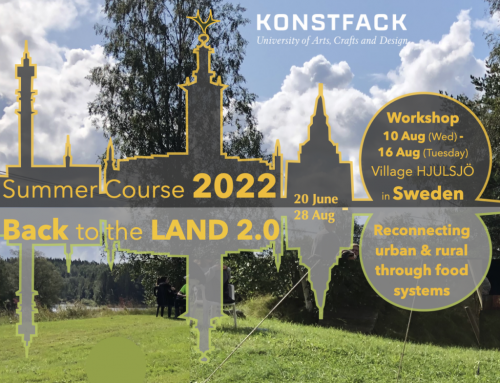Contents
1 BACKGROUND READING AND VIEWING
2 THREE OPPORTUNITY AREAS
A] Soil Care, Composting, Fermentation
B] Trees, Microparks, Edible Forests
C] Microbiome Inspired Green Infrastructure (MIGI)
1 BACKGROUND READING AND VIEWING
Bottom-Up Biodiversity (John Thackara text, 1,500w) also Biodiversità dal basso verso l’alt
http://thackara.com/place-bioregion/bottom-up-biodiversity/ + Chinese version PDF
From Microbe to Bioregion, Designing for Life (John Thackara Video, 20’)[https://www.youtube.com/watch?v=Eb2saRte9BE&t=301s]
Relational Ecology and Design (John Thackara Video, 45’)
Takeaways: sustainable design is about relationships, not just transactions; it’s about care, not consumption; sustainable design means care for all of life not just human life; these better relationships – between places, communities, and nature – can be enabled by social infrasructure, which we can design.[https://www.youtube.com/watch?v=gqjfPuLVo_w]
Design for Multispecies Cities (results of this workshop in 2022)[https://thackara.com/civicecology/design-for-multi-species-cities/]
Sharing The Land With All Life (Rebecca Hosking, 35’ video)[https://www.youtube.com/watch?v=yJeeTDgIEm0]
The historical roots of our environmental crisis (Lynn White jr 1967 text)[http://www.zbi.ee/~kalevi/lwhite.htm]
What does green infrastructure mean to you? (Kate Raworth, 5’ video) It’s not just the metric of money.[https://www.youtube.com/watch?v=ime4XO9-oGg&feature=emb_logo]
2 THREE OPPORTUNITY AREAS
2A] Soil Care, Composting, Fermentation
Soil Care Network | Soil Talks
(dip into one or two of these talks)
https://www.soilcarenetwork.com/soiltalks
Soil Care, Dr Elaine Ingham
https://www.bostontreepreservation.com/blog/2021/4/1/compost-tea-and-the-soil-food-web-with-dr-elaine-ingham
Berlin as a Farm: The case of LebensMittelPunkte
https://www.frontiersin.org/articles/10.3389/fsufs.2022.913412/full
Depaving Guidelines (143 page guide, pdf)
From the Horizon 2020 REGREEN project on nature-based solutions in urban environments in Europe and China
https://www.arb-idf.fr/fileadmin/DataStorageKit/ARB/Articles/fichiers/regreen/REGREEN_Report_3.2_IPR.pdf
Butyrite pathways
https://www.sciencedirect.com/science/article/pii/S2405844020323173
https://pubmed.ncbi.nlm.nih.gov/33684759/
Business-2-Place (B2P) Copenhagenize
https://copenhagenize.eu/project-gallery
Urban-Rural Exhibition China – Soil Zone (PPT)
The slideshow (link below) explains how the story was told in words and images.
1. The soil, and us, are one systemThe health of the soil, and the health of people, are the same story.
2. “From the Soil” (book cover: classic Chinese text)
3. The ecological restoration industry (Society of Ecological Restoration).
4. Most Ecosystems Can Recover in One Lifetime. Example: Loes Plateau, China
5. The Ten Elements of Agroecology: At its heart, the idea of a farm as a whole system, or organism.
6. The ClimateTech wiki, and the booming AgTech scene,
7. Soil Restoration: Four indicators of healthy soil: structure | microbial life | nutrient density |
8. Five farming methods
9. Five Citizen Actions
https://www.slideshare.net/johnthackara/urbanrural-exhibition-shanghai-november-2019-john-thackara-personal-slides?qid=7d8c9ff8-5a17-431e-a0e2-da7fbd2ce354&v=&b=&from_search=1
Farmer Live Streaming (Alizila article)
https://www.alizila.com/taobao-helping-farmers-reap-gains-in-livestream-boom/
2B] Trees, Microparks, Edible Forests
Microforests
https://www.sugiproject.com/projects
Tree Care As A Product Service System
Billions of trees are being planted around the world – but who will look after them, and how? New kinds of equipment and diverse disciplines need to be involved in Tree Care.Possible actors: @dmmclimbing @TreeKIT #arborist @TreekitARB[http://thackara.com/learning-design/arborists-arising-from-tree-care-to-tree-camping/]
Replacing streets with parks
Running a ‘find-and-replace’ over the city, replacing streets with parks
https://www.nesta.org.uk/feature/rethinking-parks-visions-future-innovation-parks/
Urban Nature Atlas
The richness of urban biodiversity in what used to be regarded as useless wastelands is documented in a growing number of platforms. The Urban Nature Atlas contains more than one thousand examples of nature-based solutions from across 100 European cities
https://naturvation.eu/atlas
Urban wastelands? (French article)
Unrecognized , unloved, belittled. However, studies carried out throughout Europe show that neglected spaces can incorporate the greatest urban biodiversity in flora and fauna.
https://reporterre.net/Les-friches-urbaines-sont-d-etonnants-reservoirs-de-biodiversite
The Fifteen Minute City In Images
https://www.paris.fr/pages/la-ville-du-quart-d-heure-en-images-15849
Fringe Farming
New opportunities for peri urban farming in fiveUK cities.
https://www.sharedassets.org.uk/resources/fringe-farming-2021
The bird-friendly city[https://naturecanada.ca/defend-nature/how-you-help-us-take-action/bfc/resources/?]
2C] Microbiome Inspired Green Infrastructure (MIGI)
Microbiome-inspired green infrastructure’ (MIGI) + Healthy Urban Microbiome Initiative (HUMI)
Jake Robinson
“Promoting connections with nature — including the microbes many of us currently shun — should be a key part of any post-pandemic recovery. strategy. Our cities are often lacking in biodiversity. As a result, urban dwellers are far less exposed to a diversity of health-promoting microbes. We set out a framework for construction projects so that multidisciplinary teams of researchers and practitioners can explicitly consider environmental microbiota in design and construction contexts, thereby increasing ecosystem functionality and public health”[https://www.researchgate.net/publication/341284747_Microbiome-Inspired_Green_Infrastructure_A_Toolkit_for_Multidisciplinary_Landscape_Design
https://www.mdpi.com/2078-1547/9/2/40]
Invisible Friends | Jake Robinson
https://www.jakemrobinson.com/
Bacterial Urbanism, Ann Whiston Spirn
“Cities, and the people who live in them, are part of the natural world. Cities are habitats. Cities are ecosystems. And urban ecosystems are dynamic and interconnected. Ecological urbanism weds the theory and practice of city design and planning with the insights of ecology – the study of the relationships between living organisms and their environment and the processes that shape both. It’s an approach that necessarily interacts with other environmental disciplines, such as climatology, hydrology, geography, psychology, history, and art”
http://annewhistonspirn.com/pdf/spirn_ecological_urbanism-2011.pdf
Invisible City Life: The Urban Microbiome (Marina Alberti)
Since microbes are invisible to humans, we tend to underestimate their importance in maintaining ecological and human wellbeing. Microbes play a key role in the function of ecosystems. They contribute to biodiversity, nutrient cycling ,pollutant detoxification, and human health. In urban ecosystems, microbes account for most of the biodiversity and are major agents in nature’s material cycles and food webs ). Thus the sustainability of cities over the long term is inextricably linked to microbes and their evolution.
Microbial Metrics and the Multi-Species City, Kevin Slavin, Elizabeth Hénaff
Ninety nine percent of all life on earth is invisible to the human eye, both unnamed and unnoticed. Cities are filled with people, and these people are in turn filled with billions and trillions of microorganisms. Over the past decade, this notion has become familiar through the popularization of the so-called “human microbiome,” a unique microbiological ecology in the gut of people. But does New York have a gut biome? Is it different from the gut biome of Tokyo? Lagos? Hyderabad?
https://www.aiany.org/architecture/featured-projects/view/subculture-microbial-metrics-and-the-multi-species-city/
From Control, to Kinship: Ecological Restoration in a More Than Human World (JT video 20’)
“The true potential of AI is to help us reconnect with the living, and the real:
https://www.youtube.com/watch?v=rYHUYEnjPfI&t=249″
The Ecology of Care: Medicine, Agriculture, Money, and the Quiet Power of Human and Microbial Communities (Didi Pershouse)
https://www.amazon.com/Ecology-Care-A…
Microbes and Social Equity (30’)
Dr Sue Ishaq founder of the Microbes and Social Equity working group, discusses microbes, broccoli, scallops, the digestive system of cows, food deserts, spatial planning, and social equity. It adds up to another to-do list for all of us in regenerative design.
https://video.maine.edu/media/%E2%80%9CMicrobes+at+the+nexus+of+environmental%2C+biological%2C+and+social+research%E2%80%9D%2C+Dr.+Sue+Ishaq/1_otisjuzm
Multi-Species Cities: Solarpunk Urban Futures, Christoph Ruppert et al (solarpunk book)
Cities are alive, shared by humans and animals, insects and plants, landforms and machines. What might city ecosystems look like in the future if we strive for multispecies justice in our urban settings? In these more-than-human stories, twenty-four authors investigate humanity’s relationship with the rest of the natural world, placing characters in situations where humans have to look beyond their own needs and interests. Set primarily in the Asia-Pacific, these stories engage with the serious issues of justice, inclusion, and sustainability that affect the region, while offering optimistic visions of tomorrow’s urban spaces. https://www.worldweaverpress.com/blog/cover-reveal-multispecies-cities
D Other John Thackara Content
Blog, PPTs, Case Studies, Handouts: http://thackara.com/
Publications: http://thackara.com/publications-john-thackara/
Talks on video: http://thackara.com/talks-on-video/
Slideshares: https://www.slideshare.net/johnthackara
Twitter: @johnthackara
FB: https://www.facebook.com/thackarameetup




